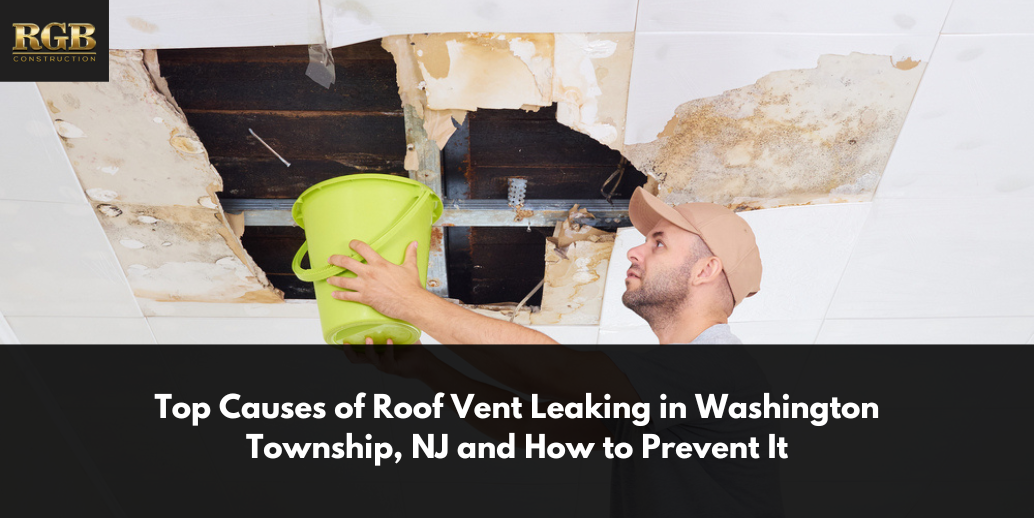The roofing system is vital to the safety and longevity of your home or commercial property. A leaking roof vent can lead to significant damage to your home if not addressed promptly. Understanding the causes and knowing how to prevent leaks can save you from costly repairs. Here’s what you need to know about roof vent leaks in Washington Township, NJ, and how to keep your roof in top condition.
Key Takeaways
- Roof vents are essential for proper attic ventilation, helping to regulate temperature and moisture levels, which prevents heat buildup in summer and moisture accumulation in winter.
- Heavy rain, snow, ice, and high winds can damage roofing materials and create leaks around roof vents by lifting shingles and flashing or causing ice dams.
- Indicators of a leaking roof vent include water stains, musty odors, visible drips, damaged shingles, and peeling paint.
- To prevent roof vent leaks, schedule regular inspections, ensure proper installation by professionals, use high-quality materials, maintain clean gutters and roof, and ensure proper attic ventilation.
What is a Roof Vent?
A roof vent is an essential component of a roofing system that allows for proper ventilation in the attic. It helps regulate temperature and moisture levels, preventing heat buildup in the summer and moisture accumulation in the winter. Common types of roof vents include ridge vents, turbine vents, and box vents. Properly functioning roof vents are crucial for maintaining the structural integrity and energy efficiency of your home.
What are the Top Causes of Leaking Roof Vents in Washington Township, NJ?
Roof vent leaks can happen for a number of reasons. When you are aware of these causes, you can begin to take preventative measures to protect your property. Let’s take a look at the top causes of roof vent leaks:
Weather-Related Causes
Washington Township experiences a variety of harsh weather conditions that can significantly impact the integrity of your roof. Heavy rain can lead to water pooling around roof vents, and if the flashing is not watertight, this pooled water can seep through, causing leaks. Snow and ice are also problematic; snow buildup and subsequent melting can create ice dams, which block the flow of melting water and cause it to back up under the shingles and around roof vents.
High winds can lift and displace shingles and flashing, creating gaps where water can enter, compromising the seal around the roof vent and causing leaks. These weather conditions can accelerate the deterioration of roofing materials, making regular maintenance and timely repairs crucial.
Poor Condition of Roofing Materials
The quality and condition of roofing materials play a significant role in preventing leaks. Over time, even the best materials can degrade due to constant exposure to the elements. Shingles can become brittle, crack, curl, or even fall off, especially as they age, creating openings for water to penetrate. Flashing, the material used to seal and protect joints and seams on the roof, can corrode, rust, or become detached over time, making it a common entry point for water.
General wear and tear from UV radiation, temperature fluctuations, and environmental pollutants contribute to the gradual breakdown of roofing materials, reducing their effectiveness in sealing out water. Regular inspections and maintenance are essential to identify and replace deteriorating materials before they cause significant problems.
Installation and Maintenance Problems
The way your roof vents are installed and maintained is critical to their performance and longevity. Improper installation of roof vents can create major weak points, such as incorrect sealing of the vents and improper installation of flashing, leaving gaps and vulnerabilities where water can easily enter. Lack of regular maintenance allows small leaks or minor damage to worsen over time, making it essential to catch and address minor issues before they become major problems.
Debris accumulation, such as leaves, branches, and other materials, can block proper water drainage and create pools of standing water. This standing water can eventually find its way through the smallest gaps or cracks, leading to leaks. Ensuring your roof vents are installed by professionals and scheduling regular maintenance can help prevent these issues.
Signs a Roof Vent is Leaking
Although there are many things that can cause a leak, you will need to keep your eyes peeled to see the signs of a leaking roof vent. Here are some things to look for if you suspect issues with the roof vent:
- Water Stains: Discoloration or water spots on the ceiling or walls.
- Musty Odors: Persistent damp smells indicating mold or mildew.
- Visible Drips: Water dripping from the ceiling during or after rain.
- Damaged Shingles: Cracked or missing shingles around the vent.
- Peeling Paint: Paint bubbling or peeling near the roof line or in the attic.
What are Some Preventative Measures to Stop Roof Vent Leaks?
Taking proactive steps can help prevent roof vent leaks and extend the life of your roofing system. Here are some preventative measures to consider:
- Regular Inspections: Schedule bi-annual roof inspections, especially after severe weather, to identify and address potential issues early.
- Proper Installation: Ensure roof vents are installed correctly by a professional contractor to avoid installation-related leaks.
- Quality Materials: Use high-quality roofing materials and flashing to provide a durable, watertight seal around vents.
- Maintenance: Keep the roof and gutters clean of debris to prevent water buildup and ensure proper drainage. Address minor repairs promptly to prevent them from becoming major issues.
- Ventilation: Ensure proper attic ventilation to reduce moisture buildup and prevent condensation-related leaks.
Contact a Roofing Contractor in Washington Township, NJ Today
Roof vent leaks can cause significant damage if not addressed promptly. If you suspect your roof vent is leaking or want to take preventive measures, contact RGB Construction. Our experienced team can assess your roof’s condition and provide expert solutions to keep your home protected. Call us today at 856-347-2297 or fill out our contact form to schedule a consultation and ensure your roof remains leak-free and in excellent condition.







